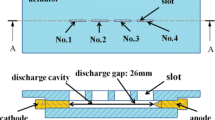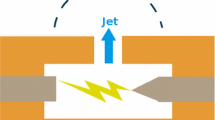Abstract
A three-electrode high-energy plasma synthetic jet (PSJ) actuator was used for shock wave control. This actuator is an enhanced version of the two-electrode actuator as a high-voltage trigger electrode is added to increase the cavity volume and the input energy while retaining a relatively low disruptive voltage. The electrical properties were studied using current-voltage measurements, and the energy consumption was calculated. To assess the jet strength, the penetration of PSJ was compared with empirical values, and the results show that the momentum flux ratio of PSJ for a capacitance of 0.96, 1.6, and 3 μF was approximately equal to 0.6, 1.0, and 1.3, respectively. The interaction of PSJ with shock waves was acquired using high-speed shadowgraph imaging. The shock was generated by a 25° compression ramp in Mach 2 flow, and PSJ actuator was placed up-stream of the compression ramp. Under the action of PSJ, the strength of the shock was notably weakened, and the near-wall part of the shock was entirely eliminated. The results show the good control effect of the three-electrode high-energy PSJ in high-speed flow.
Similar content being viewed by others
References
Bushnell D A. Shock wave drag reduction. Annu Rev Fluid Mech, 2004, 36: 81–96
Kuo S P. Plasma mitigation of shock wave: Experiments and theory. Shock Waves, 2007, 17: 225–239
Leonov S B, Yarantsev D A, Napartovich A P, et al. Plasma-assisted combustion of gaseous fuel in supersonic duct. IEEE Trans Plasma Sci, 2006, 34: 2514–2525
Shneider M N, Macheret S O, Zaidi S H, et al. Virtual shapes in supersonic flow control with energy addition. J Propuls Power, 2008, 24: 900–915
Cattafesta L N, Sheplak M. Actuators for active flow control. Annu Rev Fluid Mech, 2011, 43: 247–272
Sun Q, Cheng B Q, Li Y H, et al. Computational and experimental analysis of Mach 2 air flow over a blunt body with plasma aerodynamic actuation. Sci China Tech Sci, 2013, 56: 795–802
Sun Q, Li Y H, Cui W, et al. Shock wave-boundary layer interactions control by plasma aerodynamic actuation. Sci China Tech Sci, 2014, 57: 1335–1341
Kamran M A, Mc Guirk J J. Subsonic jet mixing via active control using steady and pulsed control jets. AIAA J, 2011, 49: 712–724
Narayanaswamy V, Raja L L, Clemens N T. Characterization of a high-frequency pulsed-plasma jet actuator for supersonic flow control. AIAA J, 2010, 48: 297–305
Grossman K R, Cybyk B Z, Van Wie D M. Sparkjet actuators for flow control. In: Proceedings of 41st Aerospace Sciences Meeting and Exhibit, Reston: AIAA, 2003
Liu R B, Niu Z G, Wang M M, et al. Aerodynamic control of NACA 0021 airfoil model with spark discharge plasma synthetic jets. Sci China Tech Sci, 2015, 58: 1949–1955
Emerick T, Ali M Y, Foster C, et al. Sparkjet characterizations in quiescent and supersonic flowfields. Exp Fluids, 2014, 55: 1858
Anderson K V, Knight D D. Plasma jet for flight control. AIAA J, 2012, 50: 1855–1872
Greene B R, Clemens N T, Magari P, et al. Control of mean separation in shock boundary layer interaction using pulsed plasma jets. Shock Waves, 2015, 25: 495–505
Narayanaswamy V, Raja L L, Clemens N T. Control of unsteadiness of a shock wave/turbulent boundary layer interaction by using a pulsed-plasma-jet actuator. Phys Fluids, 2012, 24: 076101
Sary G, Dufour G, Rogier F, et al. Modeling and parametric study of a plasma synthetic jet for flow control. AIAA J, 2014, 52: 1591–1603
Reedy T M, Kale N V, Dutton J C, et al. Experimental characterization of a pulsed plasma jet. AIAA J, 2013, 51: 2027–2031
Zong H H, Wu Y, Li Y H, et al. Analytic model and frequency characteristics of plasma synthetic jet actuator. Phys Fluids, 2015, 27: 027105
Wang L, Xia Z X, Luo Z B, et al. Three-electrode plasma synthetic jet actuator for high-speed flow control. AIAA J, 2014, 52: 879–882
Wang L, Xia Z, Luo Z, et al. Effect of pressure on the performance of plasma synthetic jet actuator. Sci China-Phys Mech Astron, 2014, 57: 2309–2315
Gruber M R, Nejadt A S, Chen T H, et al. Mixing and penetration studies of sonic jets in a Mach 2 freestream. J Propuls Power, 1995, 11: 315–323
Murugappan S, Gutmark E, Carter C. Control of penetration and mixing of an excited supersonic jet in supersonic crossflow. Phys Fluids, 2005, 17: 106101
Author information
Authors and Affiliations
Corresponding author
Rights and permissions
About this article
Cite this article
Zhou, Y., Xia, Z., Luo, Z. et al. Effect of three-electrode plasma synthetic jet actuator on shock wave control. Sci. China Technol. Sci. 60, 146–152 (2017). https://doi.org/10.1007/s11431-016-0248-4
Received:
Accepted:
Published:
Issue Date:
DOI: https://doi.org/10.1007/s11431-016-0248-4




